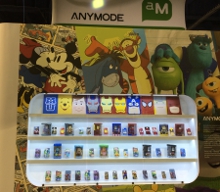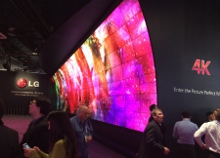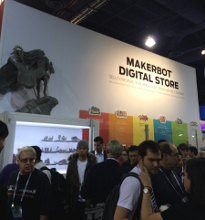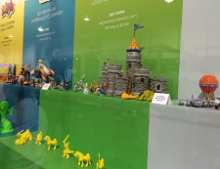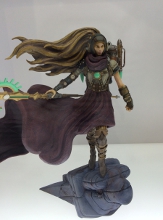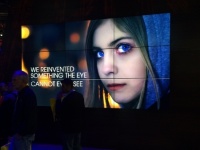 New technology and gadgets from the Consumer Electronics Show in Vegas have interesting implications for the entertainment, toy, and game businesses.
New technology and gadgets from the Consumer Electronics Show in Vegas have interesting implications for the entertainment, toy, and game businesses.Last week I was in Las Vegas for the Consumer Electronics Show (CES), the annual gathering of the gadget trade where companies reveal their hot new tech products for the coming year. As this was my first time at the show, I got lots of advice like "wear comfortable shoes," "drink lots of water" and "don’t count on getting a phone signal" that made me think CES was just a more plugged-in version of Comic-Con.
In fact, at 2.4 million square feet of floor space sprawled over several different locations (compared with 500,000 at the San Diego Convention Center), CES makes Comic-Con look like a neighborhood flea market. Samsung’s booth alone would have had a hard time fitting into Hall H.
The show itself consists of a series of self-serving keynotes by big tech, electronic and telecom executives, a few tracks of programming that seemed, from the sessions I saw, vestigial and lightly attended, and lots of after-hours parties. The main daytime activity consists of wandering the vast exhibit halls gawking at giant TVs and, since this is a trade show closed to the general public, taking meetings and placing orders.
Nerd Appeal: Because gadget nerds and comics/gaming/toy nerds occupy adjacent quadrants of the cultural landscape, there is a fair amount of overlap in terms of both exhibit-interest and attendee mindset between CES and a comic convention. Comic-style iconography and aesthetics were evident everywhere on the show floor and it was easy to bond with fellow attendees when comparing displays in the robotics pavilion to Gundam Suit mech warriors or Daleks.
That said, the demographics of CES make 1980s-era comics culture seem totally gender-neutral and female-friendly by comparison. When I arrived at the badge pickup area in the Las Vegas Airport (let me repeat that for the benefit of SDCC organizers: "Badge pickup area… at the airport"), there were 200 men in line and one woman. Booth babes--excuse me, "brand representatives,"-- remain a fundamental part of the CES atmosphere and ambiance, despite efforts of organizers to tone down the most egregious abuses.
The Big Picture: Surely the hottest technology at CES this year was the ubiquity of ultra-high definition (UHD) displays. Since 1080 lines of resolution ("True HD" 1080p) is clearly not enough for today’s discerning consumer, UHD is ready to bring 4K (2160 lines) and 8K (4320 lines) to the next generation of large flat screen TVs and monitors (as well as trippy new curved screen displays), which now routinely exceed 80 inches. The pictures on these displays are so clear that reality looks grainy and pixelated by comparison.
The big question for Samsung, Sony, LG and every other big screen pusher was "yeah, you and what content?" To take full advantage of UHD picture quality, you need original source material that was shot or mastered in the native resolution. Outside of iMAX nature documentaries screened at science museums, that means big blockbusters from the last few years--primarily comic-based superhero, sci-fi and fantasy films.
Bottom line: geek culture spectacles are an integral driver not just of media, but of the entire trillion-dollar home entertainment industry. If the manufacturers want to see their big bets on big screens pay off, they need the comics-Hollywood industrial complex to keep churning out the eye candy.
Breaking the Mold: One corner of the show floor was devoted to 3D printing. This technology, which uses lasers to sculpt solid models using chunks of plastic ("filament") based on digital plans, has always seemed to me like a solution in search of a problem. Outside of industrial product design and prototyping--not exactly mainstream consumer applications--3D printers seem destined for the niche "maker" community and the occasional gun nut who wants to print a firing pin for an automatic weapon.
Then I rounded the corner and saw the MakerBot display. This Brooklyn-based company has been in the 3D printer game since 2009, and at CES, featured a new line of custom-printed toys and fantasy gaming models. "Hero Girl," a highly detailed 36-inch warrior princess figure, perched over the threshold of the booth. She is composed of 16 molded elements that can be printed on MakerBot hardware, then assembled and painted by the consumer.
In addition, the company debuted several families of printable toys and figures with distinctive designs and a full complement of accessories, including castles, monsters, and medieval and/or sci-fi weaponry. The digital designs for each figure can be downloaded for $1-2 and fabricated using materials costing less than a dollar, on printers that start at about $1300 and are likely to see rapid price drops and capabilities improvements over the next year.
The MakerBot design team said they are all huge comics, RPG and collectibles fans, and the company envisions creating stories using comics, video, animation, motion books and other media to give each pantheon of figures a world and mythology. Customers may soon be able to submit their own designs, stories and comments on community forums. In other words, MakerBot is creating a transmedia ecosystem based on geek culture to build a new market for its hardware. Keep an eye on this.
Random Coolness: If you are into technology, CES is a cornucopia of coolness, with surprises around every corner--as long as you steer clear of the 30 acres of iPhone cases, that is. My personal favorite was in the robot area. One maker of industrial robots was demonstrating something that is essentially a Roomba for windows--a little bot that you set loose on vertical glass surfaces to get them looking sparkly and new. Around the corner was the purveyor of artificially intelligent dinosaur robots that begin as blank slates but gradually learn about their environment and can be trained to do tricks or wander randomly around your house.
My suggestion: merge the two companies to create robot dinosaurs that roam around the house cleaning windows. Surely nothing could go wrong there.
-- Rob Salkowitz (@robsalk) is author of Comic-Con and the Business of Pop Culture and is working on a new project on the future of marketing and retail in the digital age.
The opinions expressed in this column are solely those of the writer, and do not necessarily reflect the views of the editorial staff of ICv2.com.



